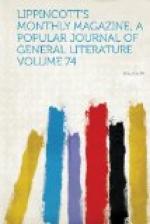Madame Charlotte’s portrait of Marie Therese, queen of Le Grand Monarque, is not very flattering: “Her teeth were black and broken, and she ate immoderately of garlic and chocolate. She was very fond of basset, but she never won, for she could never learn to play any game. She ate long and very slowly, taking mouthfuls for a canary.” The diagnosis of the disease of which the queen died displays the popular pathological lore of those times. Madame says: “She died of an abscess on the arm, for which Fagon bled her. The humor entered and fell on the heart: he then gave her an emetic to remove the humor, and this suffocated her.” La Valiere, according to Madame Charlotte, was the only woman who ever really loved the king. She limped a little, had lovely eyes, irregular teeth, and was very neat in her person, while Madame de Montespan was just the reverse.
Of Cardinal Richelieu we have a glimpse in madame’s letters which his biographers, generally at least, omit. She tells us that he used to have violent fits of insanity, during which he would imagine that he was a horse, jump over a billiard-table, kick his servants, neigh, and make a fearful noise for an hour. His domestics would then get him into bed, and after much sweating he would wake without the least memory of what had passed. As “jumping over a billiard-table” might appear an incredible feat, at least for an aged cardinal, it is proper to remark that the billiard-tables of those times bore about the same relation in size to our modern billiard-tables that the ancient spinnet did to a grand pianoforte.
JAPANESE ART.
Some of our young ladies have a pretty art of constructing miniature landscapes out of pebbles and mosses, strips of glistening paper for brooks, little fuzzy pine sticks painted green for trees, and animals and Swiss cottages from the toy-shop. Could these amateur artists once see how the Japanese do this thing, they would abandon their mosses and pebbles in despair. A late traveler in Japan says of one of these: “It was a fairy-like landscape seen through a spy-glass reversed.” Some of the details were real trees dwarfed to pigmies by the art of the Oriental florist. There were limpid lakes peopled with gold-fish; grottos and summer-houses of exquisite finish draped with growing verdure and large enough to shelter a small company of rabbits: lovely walks winding through groves, lawns and by miniature parterres of flowers, and finally, liliputian canals, spanned by elegant bridges wide enough for the passage of a large rat.




